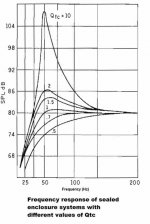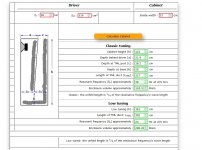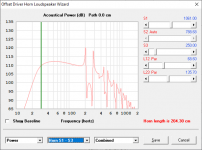I've been using a few online calculators to play around with possible boxes for the drivers I have coming and all the calculators come up with boxes that give a Vb of about twice the Vas.
Is this normal?
Although I've had help in the past with a design or two for other woofers I've never actually got around to building any of them due to poor WAF
These are for my Mancave so size won't be a problem this time around.
Just an idle thought here that perhaps the reputation for deep bass is simply the better F10 you get with sealed boxes and a "Q" of 0.5 or less??
I could never afford the IMF Studio Monitors that in my early years had the best bass I've ever heard Pre-Subwoofers and DSP
Is this normal?
Although I've had help in the past with a design or two for other woofers I've never actually got around to building any of them due to poor WAF
These are for my Mancave so size won't be a problem this time around.
Just an idle thought here that perhaps the reputation for deep bass is simply the better F10 you get with sealed boxes and a "Q" of 0.5 or less??
I could never afford the IMF Studio Monitors that in my early years had the best bass I've ever heard Pre-Subwoofers and DSP
Well, a max flat vented alignment is where Vb = Vas, Fb = Fs, Qts' = ~0.403 based on this formula with Qts' dominating till Vas gets relatively large: 20*Vas*Qts'^3.3
[Qts']: [Qts] + any added series resistance [Rs]: Calculate new Qts with Series Resistor
[Rs] = 0.5 ohm minimum for wiring, so may be higher if a super small gauge is used as a series resistor plus any added resistance from an XO/whatever.
Right, sealed goes lower, but misses out on the vented's extra half octave of [mid] bass gain before its steeper roll-off.
[Qts']: [Qts] + any added series resistance [Rs]: Calculate new Qts with Series Resistor
[Rs] = 0.5 ohm minimum for wiring, so may be higher if a super small gauge is used as a series resistor plus any added resistance from an XO/whatever.
Right, sealed goes lower, but misses out on the vented's extra half octave of [mid] bass gain before its steeper roll-off.
Attachments
I've been using a few online calculators to play around with possible boxes for the drivers I have coming and all the calculators come up with boxes that give a Vb of about twice the Vas. Is this normal?
Given the subject of your post "A TL question", I assume that you're looking at online calculators for TLs?
Most of the online calculators for TL are pretty much ********. They base their calculations on just driver Sd and Fs, completely ignoring Vas and at Qts (or Qes and Qms).
If any of those online calculators don't at least take the following driver parameters into consideration, then they're ********: Vas, Fs, Qts (or Qes and Qms).
A well known set of pages that are sometimes useful.
What I was wanting to do was to set that box design into Horn Response and see what was going to happen if I did use that set of measurements.
I want a new set of Mancave speakers and I do want to use the NOS Kicker when it arrives but I want deeper bass than I can get from a sealed box and I really do want to build a "Transmission Line" box.
I have a folding in my head although not yet set down on paper
What I was wanting to do was to set that box design into Horn Response and see what was going to happen if I did use that set of measurements.
I want a new set of Mancave speakers and I do want to use the NOS Kicker when it arrives but I want deeper bass than I can get from a sealed box and I really do want to build a "Transmission Line" box.
I have a folding in my head although not yet set down on paper
Attachments
I guess this would be as good as or better than many of those sites to get you started. Bear in mind that this is just to START you off - the equations describe an unstuffed TL with constant cross-sectional area, and you'll most likely need to tweak the size, length and expansion rate and stuffign of your build to get better results, particularly as these equations do not take Le into consideration or the useful bandwidth that you're trying to achieve.
Given:
Fs = Driver resonance frequency (Hz
Qts = Driver Q at resonance
Vas = Driver's equivalent air compliance (litres)
Calculate:
Fb = Fs / (2.53 * Qts)
Vb = 20 * Vas * Qts ^ 2.35
L = 8500 / Fb
CSA = Vb * 1000 / L
Where,
Fb = TL resonance frequency (Hz)
Vb = TL net volume (litres)
L = TL path length (cm)
CSA = cross-sectional area along the TL's path (cm^2)
Given:
Fs = Driver resonance frequency (Hz
Qts = Driver Q at resonance
Vas = Driver's equivalent air compliance (litres)
Calculate:
Fb = Fs / (2.53 * Qts)
Vb = 20 * Vas * Qts ^ 2.35
L = 8500 / Fb
CSA = Vb * 1000 / L
Where,
Fb = TL resonance frequency (Hz)
Vb = TL net volume (litres)
L = TL path length (cm)
CSA = cross-sectional area along the TL's path (cm^2)
It's an old [ NOS] Kicker the 12 inch in this link Brian
http://www.kicker.com/app/manuals/subwoofers/es/2005_ES_Sub.pdf
I know they work well in sealed boxes as I have the 15" already but poor WAF
http://www.kicker.com/app/manuals/subwoofers/es/2005_ES_Sub.pdf
I know they work well in sealed boxes as I have the 15" already but poor WAF
Yeah, those specs are going to result in a pretty large TL.
I was able to sim a much smaller (134 L TL) with that driver by aiming for a higher Fb of 30 Hz, tapering the design and allowing a bit of a rolloff at the low end, but 134 L still adds up to a fairly big box for a 12" driver with a 7.5" Xmax. It's going to exceed its excursion capabilities with about 100W of power.
I was able to sim a much smaller (134 L TL) with that driver by aiming for a higher Fb of 30 Hz, tapering the design and allowing a bit of a rolloff at the low end, but 134 L still adds up to a fairly big box for a 12" driver with a 7.5" Xmax. It's going to exceed its excursion capabilities with about 100W of power.
Attachments
- Home
- Loudspeakers
- Subwoofers
- A TL question


